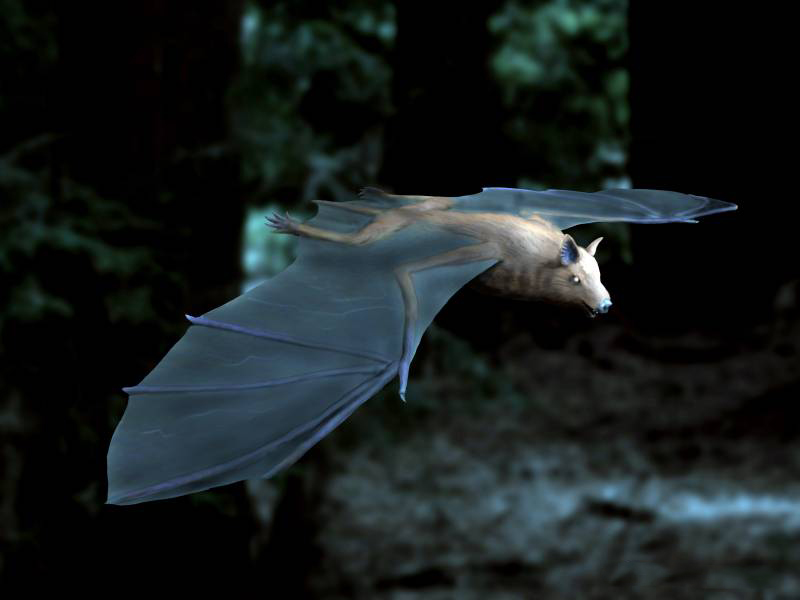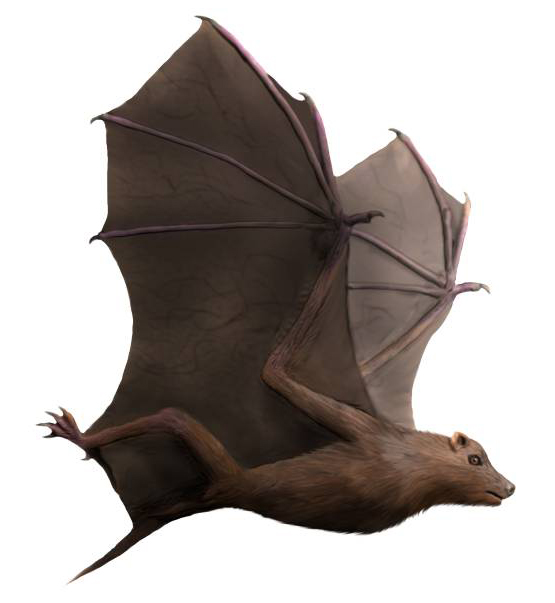|
Icaronycteris
''Icaronycteris'' is an extinct genus of microchiropteran (echolocating) bat that lived in the early Eocene, approximately , making it the earliest known definitive bat. Four exceptionally preserved specimens, among the best preserved bat fossils, are known from the Green River Formation of North America. There is only one thoroughly described species of bat in the genus, ''I. index'', although fragmentary material from France has also been tentatively placed within ''Icaronycteris'' as the second species ''I. menui''. ''I. sigei'' is based on well-preserved fragments of dentaries and lower teeth found in Western India. Description ''Icaronycteris'' measured about long and had a wingspan of . It closely resembled modern bats, but had some primitive traits. The tail was much longer and not connected to the hind legs with a skin membrane, the first wing finger bore a claw and the body was more flexible. Similarly, it had a full set of relatively unspecialised teeth, similar to th ... [...More Info...] [...Related Items...] OR: [Wikipedia] [Google] [Baidu] |
Palaeochiropteryx
''Palaeochiropteryx'' ( ) is an extinct genus of bat from the Middle Eocene of Europe and North America. It contains three very similar species – ''Palaeochiropteryx tupaiodon'' and ''Palaeochiropteryx spiegeli'', both from the famous Messel Pit of Germany, as well as ''Palaeochiropteryx sambuceus'' from the Sheep Pass Formation (Nevada, United States). They are usually found complete and exceptionally preserved, even retaining the outlines of their fur, ears, and wing membranes. They are one of the oldest bats known, existing around 48 million years ago. Despite this, they were already quite advanced, showing evidence of the ability to hunt by echolocation like modern insect-eating bats. ''Palaeochiropteryx'' were small bats, with a wingspan between . Their wings were short but broad, indicating an adaptation for slow but highly maneuverable flight beneath forest canopies and among dense vegetation. They preyed mostly on moths and caddisflies and were probably nocturnal. ... [...More Info...] [...Related Items...] OR: [Wikipedia] [Google] [Baidu] |
Green River Formation
The Green River Formation is an Eocene geologic formation that records the sedimentation in a group of intermountain lakes in three basins along the present-day Green River in Colorado, Wyoming, and Utah. The sediments are deposited in very fine layers, a dark layer during the growing season and a light-hue inorganic layer in the dry season. Each pair of layers is called a varve and represents one year. The sediments of the Green River Formation present a continuous record of six million years. The mean thickness of a varve here is 0.18 mm, with a minimum thickness of 0.014 mm and maximum of 9.8 mm.Bradley, W. H. The varves and climate of the Green River epoch: U.S. Geol. Survey Prof. Paper 158, pp 87–110, 1929. The sedimentary layers were formed in a large area named for the Green River, a tributary of the Colorado River. The three separate basins lie around the Uinta Mountains (north, east, and south) of northeastern Utah: * an area in northwestern Colorado east ... [...More Info...] [...Related Items...] OR: [Wikipedia] [Google] [Baidu] |
Onychonycteris
''Onychonycteris'' is the more primitive of the two oldest known monospecific genera of bat, having lived in the area that is current day Wyoming during the Eocene period, 52.5 million years ago. Taxonomy Two specimens of ''Onychonycteris'' were found in the Green River Formation in 2003, and placed in a new family when the discovery was published in ''Nature'', in February 2008. ''Onychonycteris'' means "clawed bat", in reference to the fact that this animal had claws on all five of its digits, whereas modern bats only have claws on the thumb (in most species) or thumb and index finger (in pteropodids). The specific epithet is a tribute to the fossil prospector and preparator who discovered it, Bonnie Finney. Description ''Onychonycteris'' was unique among bats in that it had claws on all five fingers, as opposed to two or three in all other known species. Its unique limb proportions represent an intermediate between bats and non-flying mammals, with longer hind-limbs and p ... [...More Info...] [...Related Items...] OR: [Wikipedia] [Google] [Baidu] |
Australonycteris
''Australonycteris'' is an extinct and monotypic genus of microchiropteran bat with the single species ''Australonycteris clarkae''. The species is known from fragmentary remains found at the Murgon fossil site, in south-eastern Queensland, dating to the early Eocene, 54.6 million years ago. It is the oldest bat from the Southern Hemisphere and one of the oldest bats in the world, and inhabited forests and swampy areas, with a diet of insects and possibly small fish. Taxonomy A monotypic genus allied to the family Archaeonycteridae, or classified by an indeterminate familial arrangement, describing fossil A fossil (from Classical Latin , ) is any preserved remains, impression, or trace of any once-living thing from a past geological age. Examples include bones, shells, exoskeletons, stone imprints of animals or microbes, objects preserved ... material collected at Murgon in 1994. The type specimen is a tooth. The material was discovered at the Tingamarra Local Fauna ... [...More Info...] [...Related Items...] OR: [Wikipedia] [Google] [Baidu] |
Eocene Bats
The Eocene ( ) Epoch is a geological epoch that lasted from about 56 to 33.9 million years ago (mya). It is the second epoch of the Paleogene Period in the modern Cenozoic Era. The name ''Eocene'' comes from the Ancient Greek (''ēṓs'', "dawn") and (''kainós'', "new") and refers to the "dawn" of modern ('new') fauna that appeared during the epoch. The Eocene spans the time from the end of the Paleocene Epoch to the beginning of the Oligocene Epoch. The start of the Eocene is marked by a brief period in which the concentration of the carbon isotope 13C in the atmosphere was exceptionally low in comparison with the more common isotope 12C. The end is set at a major extinction event called the ''Grande Coupure'' (the "Great Break" in continuity) or the Eocene–Oligocene extinction event, which may be related to the impact of one or more large bolides in Siberia and in what is now Chesapeake Bay. As with other geologic periods, the strata that define the start and end of ... [...More Info...] [...Related Items...] OR: [Wikipedia] [Google] [Baidu] |
Prehistoric Bat Genera
Prehistory, also known as pre-literary history, is the period of human history between the use of the first stone tools by hominins 3.3 million years ago and the beginning of recorded history with the invention of writing systems. The use of symbols, marks, and images appears very early among humans, but the earliest known writing systems appeared 5000 years ago. It took thousands of years for writing systems to be widely adopted, with writing spreading to almost all cultures by the 19th century. The end of prehistory therefore came at very different times in different places, and the term is less often used in discussing societies where prehistory ended relatively recently. In the early Bronze Age, Sumer in Mesopotamia, the Indus Valley Civilisation, and ancient Egypt were the first civilizations to develop their own scripts and to keep historical records, with their neighbors following. Most other civilizations reached the end of prehistory during the following Iron Age. ... [...More Info...] [...Related Items...] OR: [Wikipedia] [Google] [Baidu] |
Dorling Kindersley
Dorling Kindersley Limited (branded as DK) is a British multinational publishing company specialising in illustrated reference books for adults and children in 63 languages. It is part of Penguin Random House, a subsidiary of German media conglomerate Bertelsmann. Established in 1974, DK publishes a range of titles in genres including travel (including DK Eyewitness travel), history, geography, science, space, nature, sports, gardening, cookery and parenting. The worldwide co-CEOs of DK is Paul Kelly and Rebecca Smart. DK has offices in New York, Melbourne, London, Munich, New Delhi, Toronto, Madrid, Beijing, and Jiangmen. DK works with licensing partners such as Disney, LEGO, DC Comics, the Royal Horticultural Society, MasterChef, and the Smithsonian Institution. DK has commissioned Mary Berry, Monty Don, Robert Winston, Huw Richards, and Steve Mould for a range of books. History DK was founded in 1974 by Christopher Dorling and Peter Kindersley in London as a book ... [...More Info...] [...Related Items...] OR: [Wikipedia] [Google] [Baidu] |
Simon & Schuster
Simon & Schuster () is an American publishing company and a subsidiary of Paramount Global. It was founded in New York City on January 2, 1924 by Richard L. Simon and M. Lincoln Schuster. As of 2016, Simon & Schuster was the third largest publisher in the United States, publishing 2,000 titles annually under 35 different imprints. History Early years In 1924, Richard Simon's aunt, a crossword puzzle enthusiast, asked whether there was a book of ''New York World'' crossword puzzles, which were very popular at the time. After discovering that none had been published, Simon and Max Schuster decided to launch a company to exploit the opportunity.Frederick Lewis Allen, ''Only Yesterday: An Informal History of the 1920s'', p. 165. . At the time, Simon was a piano salesman and Schuster was editor of an automotive trade magazine. They pooled , equivalent to $ today, to start a company that published crossword puzzles. The new publishing house used "fad" publishing to publish bo ... [...More Info...] [...Related Items...] OR: [Wikipedia] [Google] [Baidu] |
Royal Ontario Museum
The Royal Ontario Museum (ROM) is a museum of art, world culture and natural history in Toronto, Ontario, Canada. It is one of the largest museums in North America and the largest in Canada. It attracts more than one million visitors every year, making the ROM the most-visited museum in Canada. The museum is north of Queen's Park, in the University of Toronto district, with its main entrance on Bloor Street West. Museum subway station is named after the ROM and, since a 2008 renovation, is decorated to resemble the institution's collection at the platform level. Established on April 16, 1912, and opened on March 19, 1914, the museum has maintained close relations with the University of Toronto throughout its history, often sharing expertise and resources. The museum was under the direct control and management of the University of Toronto until 1968, when it became an independent Crown agency of the Government of Ontario. Today, the museum is Canada's largest field-research in ... [...More Info...] [...Related Items...] OR: [Wikipedia] [Google] [Baidu] |




